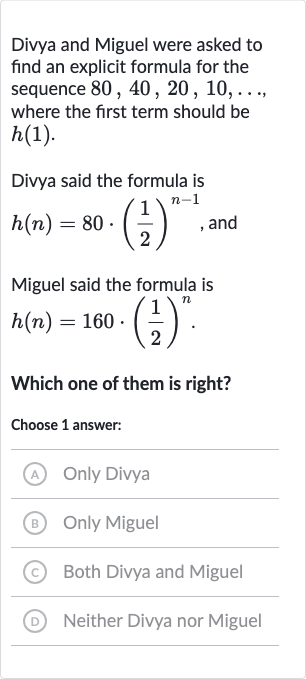AI tutor
Welcome to Bytelearn!
Let’s check out your problem:

Divya and Miguel were asked to find an explicit formula for the sequence , where the first term should be .Divya said the formula is , andMiguel said the formula is .Which one of them is right?Choose answer:(A) Only Divya(B) Only Miguel(C) Both Divya and Miguel(D) Neither Divya nor Miguel
Full solution
Q. Divya and Miguel were asked to find an explicit formula for the sequence , where the first term should be .Divya said the formula is , andMiguel said the formula is .Which one of them is right?Choose answer:(A) Only Divya(B) Only Miguel(C) Both Divya and Miguel(D) Neither Divya nor Miguel
- Question Prompt: The question prompt is: "Which formula correctly represents the explicit formula for the sequence ?"
- Sequence Analysis: We have the sequence: This sequence is geometric because each term is obtained by multiplying the previous term by a common ratio.
- Finding the Common Ratio: To find the common ratio , we divide the second term by the first term: .
- First Term of the Sequence: The first term of the sequence is , so .
- Explicit Formula for the nth Term: Using the common ratio and the first term, we can write the explicit formula for the nth term of the sequence as .Substituting the values we have .
- Checking Divya's Formula: Now let's check Divya's formula: .This matches the formula we derived, so Divya's formula is correct.
- Checking Miguel's Formula: Let's check Miguel's formula: .To see if this formula is correct, we can test it for . If Miguel's formula is correct, should equal .Calculating using Miguel's formula gives us .This is also correct because it gives us the first term of the sequence.
- Validity of Formulas: Since both Divya's and Miguel's formulas give the correct first term and follow the pattern of the sequence, both formulas are correct.
